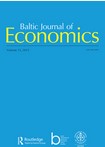Southern and Eastern Europe in the Eurozone: convergence or divergence?
Southern and Eastern Europe in the Eurozone: convergence or divergence?
Author(s): Andrea BolthoSubject(s): National Economy, Supranational / Global Economy, Economic history, Economic policy, International relations/trade, Comparative politics, Economic development, Transformation Period (1990 - 2010), Present Times (2010 - today), EU-Approach / EU-Accession / EU-Development, Financial Markets
Published by: BICEPS/SSE Riga
Keywords: Convergence; monetary union; economic history; economic growth;
Summary/Abstract: A number of studies have concluded that, contrary to expectations, European monetary union has not reduced income disparities among the 12 Western European member countries. In fact, incomes per capita between Southern and Northern Eurozone members have diverged since the Eurozone was created, in contrast to earlier trends which had seen rapid convergence in living standards across Western Europe. The paper revisits this issue and investigates whether something similar occurred in the five Eastern European countries (Estonia, Latvia, Lithuania, Slovakia and Slovenia) which joined the Eurozone between 2007 and 2015. The conclusion is that, despite similarities with Southern Europe in some areas, overall developments in Eastern Europe were different and led to convergence rather than divergence. Important reasons for this were Eastern Europe’s relatively high levels of institutional quality, a politically motivated determination to anchor these countries to the West and, possibly, the legacy of pre-war history.
Journal: Baltic Journal of Economics
- Issue Year: 20/2020
- Issue No: 1
- Page Range: 74-93
- Page Count: 20
- Language: English

